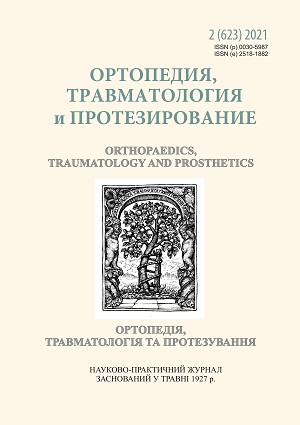Biochemical and immunological blood parameters in patients with inflammatory complications after spine screw fixation
DOI:
https://doi.org/10.15674/0030-59872021223-27Keywords:
Surgical treatment, spinal disease, complications, inflammation, screw fixation, laboratory parametersAbstract
As a result of screw fixation at the surgical treatment of patients with spinal diseases, certain complications may occur, of which soft tissues inflammation is frequent. Therefore, it is especially important to study the metabolic status of patients before surgery to determine the increased possibility of complications. Objective. To study the biochemical and immunological blood serum parameters and determine their diagnostic sensitivity in patients with the thoracic and lumbar spine diseases after screw fixation with postoperative inflammatory response. Methods. Comparisons of blood parameters were carried out in two groups of 20 patients in each group: the first one — patients at whom the postoperative period passed without complications, the second group — a soft tissues inflammation around the metal structure was observed in the postoperative period. Blood for the study was taken before the surgery on an empty stomach for determination of: C-reactive protein (CRP), sialic acid, alkaline phosphatase (ALP) activity, haptoglobin, content of total chondroitin sulfate (ChS), glycoproteins, circulating immune complexes (CIC), the rate of spontaneous lymphocyte migration, the level of lymphocyte migration with antibodies to bone and cartilage antigens. For quantitative characterization of diagnostic reliability of laboratory test was used the criterion of diagnostic sensitivity. Results. In patients with postoperative soft tissue inflammation around the metal device before surgery, the following indicators were the most informative: the content of ChS (95 %), CRP (80 %), glycoproteins (95 %), haptoglobin (92 %), ALP activity (80 %), sialic acid content (90 %), CIC concentration (70 %), the rate of spontaneous lymphocyte migration (65 %). Conclusions. The laboratory parameters complex with the highest diagnostic sensitivity can be recommended for the selection of preventive measures in the preoperative period, which will improve the results of surgical treatment, reduce its duration and costs.
References
- Roussouly, P., & Nnadi, C. (2010). Sagittal plane deformity: An overview of interpretation and management. European Spine Journal, 19(11), 1824-1836. https://doi.org/10.1007/s00586-010-1476-9
- Vlaeyen, J. W., Maher, C. G., Wiech, K., Van Zundert, J., Meloto, C. B., Diatchenko, L., Battié, M. C., Goossens, M., Koes, B., & Linton, S. J. (2018). Low back pain. Nature Reviews Disease Primers, 4(1). https://doi.org/10.1038/s41572-018-0052-1
- Mehta, V. A., Amin, A., Omeis, I., Gokaslan, Z. L., & Gottfried, O. N. (2011). Implications of Spinopelvic alignment for the spine surgeon. Neurosurgery, 76(suppl_1), S42-S56. https://doi.org/10.1227/01.neu.0000462077.50830.1a
- Azimi, P., Yazdanian, T., Benzel, E. C., Aghaei, H. N., Azhari, S., Sadeghi, S., & Montazeri, A. (2020). Accuracy and safety of C2 pedicle or pars screw placement: A systematic review and meta-analysis. Journal of Orthopaedic Surgery and Research, 15(1). https://doi.org/10.1186/s13018-020-01798-0
- Radchenko, V. O., Skidanov, A. G., & Morozenko, D. V. (2018). Dynamics of biochemical blood markers in patients after surgical treatment of degenerative diseases of the lumbar spine. Ukrainian Journal of Medicine, Biology and Sports, 7(16), 140–145. [in Ukrainian]
- Leontyeva, F. S., & Morozenko, D. V. (2016). Biochemical markers of connective tissue metabolism in osteochondrosis of the lumbar spine. Pivdennoukrainian Medical Science Journal, 13, 100–102. [in Russian]
- Medvedev, V. V., Volchek, Yu. Z., & Yakovlev, V. A. (2006). Clinical laboratory diagnostics. 3rd revised and add. SPb : Hippocrates. [in Russian]
- Vlizla, V. V. (2012). Laboratory research methods in biology, animal husbandry and veterinary medicine: handbook. Lviv: SPOLOM. [in Ukrainian]
- Tymoshenko, O. P., Voronina, L. M., & Kravchenko, V. M. (2003). Clinical biochemistry: textbook. Kharkiv : Golden Pages. [in Ukrainian]
- Belotskiy, S. M., & Avtalion, R. R. (2008). Inflammation. Cell mobilization and clinical effects. M.: Binom. [in Russian]
- Karpishchenko, A. I. (1999). Medical laboratory technologies and diagnostics. SPb: Intermedica. [in Russian]
- Lebedev K. A., & Ponyakina, I. D. (2009). Immunology of image-recognizing receptors. Integral immunology. Moscow : Librokom. [in Russian]
- Kalashnikov, V. S. (2003). Clinical and biochemical laboratory diagnostics. Minsk : Interpressservice. [in Russian]
- Lang, T. A., & Sesik, M. M. (2011). How to describe statistics in medicine. A guide for authors, editors and reviewers. Moscov : Practical Medicine. [in Russian]
- Dochilova, E. S., Chernigova, S. V., & Chernigov, Yu. V. (2018). Biochemical and hematological blood parameters of dogs in transpedicular osteosynthesis of the lumbar spine. Issues of legal regulation in veterinary medicine, 2, 85–88. [in Russian]
- Bokov, A. E., Mlyavykh, S. G., Bratsev, I. S., & Dydykin, A. V. (2020). Factors affecting the stability of transpedicular fixation in patients with unstable injuries of the lumbar spine and transitional thoracolumbar region. Innovative Medicine of Kuban, 3(19), 12–19. https://doi.org/10.35401/2500-0268-2020-19-3-12-19. [in Russian]
- Makarevich, S. V. (2018). Historical aspects of transpedicular fixation of the spine: a literature review. Spine surgery, 15(4), 95–106. https://doi.org/10.14531/2018.4.95-106. [in Russian]
Downloads
How to Cite
Issue
Section
License

This work is licensed under a Creative Commons Attribution 4.0 International License.
The authors retain the right of authorship of their manuscript and pass the journal the right of the first publication of this article, which automatically become available from the date of publication under the terms of Creative Commons Attribution License, which allows others to freely distribute the published manuscript with mandatory linking to authors of the original research and the first publication of this one in this journal.
Authors have the right to enter into a separate supplemental agreement on the additional non-exclusive distribution of manuscript in the form in which it was published by the journal (i.e. to put work in electronic storage of an institution or publish as a part of the book) while maintaining the reference to the first publication of the manuscript in this journal.
The editorial policy of the journal allows authors and encourages manuscript accommodation online (i.e. in storage of an institution or on the personal websites) as before submission of the manuscript to the editorial office, and during its editorial processing because it contributes to productive scientific discussion and positively affects the efficiency and dynamics of the published manuscript citation (see The Effect of Open Access).














